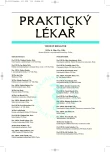Birth Defects Registration in the Czech Republic: Past and Present
Authors:
A. Šípek 1,2; Gregor V. Horáček J. 1,3 1,4
Authors‘ workplace:
Oddělení lékařské genetiky, Fakultní Thomayerova nemocnice, Praha
Primář: MUDr. Vladimír Gregor
1; 3. Lékařská fakulta Univerzity Karlovy
Děkan: doc. MUDr. Bohuslav Svoboda, CSc.
2; Katedra lékařské genetiky, Institut postgraduálního vzdělávání ve zdravotnictví, Praha
Vedoucí: prof. MUDr. Petr Goetz, CSc.
3; Gennet, Praha
Vedoucí: MUDr. David Stejskal
4
Published in:
Prakt. Lék. 2008; 88(10): 590-598
Category:
Of different specialties
Overview
Aim of study:
Analysis of the occurrence of total birth defects, as well as their relative rates, in the Czech Republic between 1981 and 2006. A comparison of observed and expected incidences from the same time period.
Type of study:
Retrospective epidemiologic analysis of data from 1981 to 2006 from the Czech Republic.
Methodology:
Expected (E) incidences from 1981–2006 were calculated from the mean observed (O) incidences from 1961–1980 and from actual annual birth numbers from 1981–2006. These E incidences were compared to O incidences from the same period (1981–2006). O/E >1 means that the number of diagnosed birth defects is higher than the number expected, i.e. the incidence of a particular birth defect is increasing and vice versa for O/E<1.
Results and conclusion:
In the Czech Republic, birth defect registration on a national scale has taken place since 1961. There are currently more types of birth defect being registered than a few decades ago, which is regarded as the main cause of a recent increase in total birth defect incidence. However, incidences of some particular birth defects are decreasing as a result of advances in prenatal diagnosis and related screening programmes (neural tube defects, congenital heart and abdominal wall defects, some chromosomal syndromes etc.).
On the other hand, the incidences of certain birth defects have increased in recent years which may be due to better diagnostic ascertainment or due to more available and widespread screening programmes and techniques (congenital hydrocephalus, kidney defects e.g.) or perhaps there is a “true” increase as has been shown for hypospadia, oesophageal defects or anorectal atresia.
Key words:
birth defect, prenatal diagnostics, epidemiology, anencephaly, spina bifida, encephalocele, neural tube defects, congenital hydrocephalus, omphalocele, gastroschisis, abdominal wall defects, diaphragmatic hernia, renal agenesis/hypoplasia, cystic kidney, congenital oesophageal defects, anorectal malformations, cleft palate, cleft lip and/or palate, facial clefts, Down syndrome, Czech Republic.
Sources
1. Šípek, A., Gregor, V., Horáček, J., Mašátová, D. Průběžné sledování vrozených vad u dětí v České republice. Historie a současnost. Čes. gynek. 2003, 68, 2, s. 71-80.
2. Šípek, A., Gregor, V., Horáček, J., Mašátová, D., Světnicová, K. Čtvrtletní sledování četností vrozených vad u dětí v České republice. Čes.-slov. pediat., 2003, 58, 3, s. 162-169.
3. Šípek, A., Gregor, V., Krofta, L., Horáček, J., Mašátová, D., Světnicová, K. Historie registrace vrozených vad v České republice. Čes. gynek. 2004, 69, 2, s. 113-125.
4. Šípek, A., Gregor, V., Horáček, J., Mašátová, D., Světnicová, K. Čtvrtletní sledování četnosti vrozených vad u dětí v České republice v období 1994-2002. Demografie 2004, 46, s. 296-301
5. Šípek, A., Gregor, V., Horáček, J. Čtvrtletní incidence vybraných typů vrozených vad v České republice v období 1994-2005: dvanáctileté období. Čes. gynek., 2007, 72, 4, s. 254-261.
6. Gregor, V., Šípek, A., Horáček, J. Vrozené vady v České republice – prenatální diagnostika. Čes. gynek., 2007, 72, 4, s. 262-268.
7. Šípek, A., Gregor, V., Horáček, J. Vrozené vady v České republice v období 1961 až 2005 – průměrné incidence. Čes. gynek., 2007, 72, 3, s. 185-191.
8. Gregor, V., Šípek, A., Horáček, J., Šípek, A. Jr, Langhammer, P. Prenatální diagnostika vybraných typů vrozených vad v České republice v období 1994-2006. Čes. gynek. 2008, 73, 3, s. 169-178.
9. Gregor, V., Šípek, A., Horáček, J., Šípek, A. jr., Langhammer, P. Přežívání dětí s vybranými vrozenými vadami v průběhu prvního roku života. Čes. gynek. 2008, 73, 3, s. 163-169.
Labels
General practitioner for children and adolescents General practitioner for adultsArticle was published in
General Practitioner

2008 Issue 10
- Hope Awakens with Early Diagnosis of Parkinson's Disease Based on Skin Odor
- Memantine Eases Daily Life for Patients and Caregivers
- Metamizole vs. Tramadol in Postoperative Analgesia
- Memantine in Dementia Therapy – Current Findings and Possible Future Applications
- What Effect Can Be Expected from Limosilactobacillus reuteri in Mucositis and Peri-Implantitis?
Most read in this issue
- Guillain-Barré syndrome. Specific features of intensive care, potential for therapeutic use of plasmapheresis, and our experience
- Common basic classifications of child fractures
- Mentalization
- Uncommon nasopharyngeal tumor in old age - nasopharyngeal angiofibroma?
